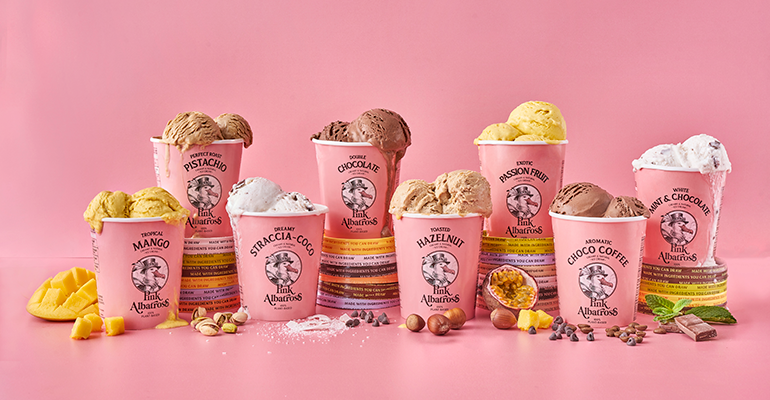News
Pink Albatross on getting the right formulation for clean label ice cream
27 Oct 2023Plant-based ice cream brand Pink Albatross has made its clean label ingredient list a focal point of its branding and packaging. “We only use ingredients we can draw…. And it's quite difficult to draw methylcellulose or mono and di-glycerides of fatty acids,” it says.
Based in Madrid, Pink Albatross has become a market leader in the plant-based ice cream category in Spain, recently overtaking Ben & Jerry’s, according to co-founder of the company Jose Luis Biaggio.

It is listed in a total of 1,500 supermarkets around Spain including Carrefour, Corte Ingles, and Costco, and is also present in Portugal and Germany. It expects to launch in Carrefour in France in the next few months.
The brand has eight flavours in its current range: chocolate & coffee; hazelnut; passionfruit; mango; coconut; chocolate; straccia-coco; mint & chocolate; and pistachio. In the coming months, it plans on launching chocolate covered ice cream lollies.
Biaggio told Ingredients Network the company is proud of its clean label ingredient list. “We only use ingredients that we can draw. You can draw a mango or a cashew nut. It's quite difficult to draw methylcellulose or mono and di-glycerides of fatty acids. Nobody knows what that is, however, they are quite common in the ice cream industry.”
The importance of having a clean label ingredient list was personal, the co-founder explained.
"One of my biggest pain points when I was looking for food for my daughter was going to the supermarket and having to check if the products were suitable,” Biaggio said. “And each time I thought, 'what is that ingredient?'. So that's why we dedicate about one-third of the pack just to telling people about the ingredients.”
Although required to list the ingredients in text form to comply with food labelling regulations, Pink Albatross also draws its ingredients in pictorial form.
"There is no definition of clean label so we tell you what it means,” Biaggio said. “We only use ingredients that have been obtained by mechanical force, heat, or fermentation. That's it. If there is anything else like solvents or chemicals, we are not going to use it.
"So, even the cocoa that we use is not Dutch cocoa because that is a chemical process that uses a solvent to bring the acidity level of the cocoa down. We don't use any Dutch processed cocoa.”
He added: “It is quite challenging to be our ingredient supplier!”
‘Optimised for pleasure, not nutrition’
The ingredient list of Pink Albatross’ pistachio ice cream is water, coconut milk, cashew nut paste, sugar, pistachio paste, coconut oil, vegetable gums, and salt. It uses sugar to sweeten its ice cream, which it describes as an indulgent product.
"We haven't optimised for nutrition, we've optimised for pleasure,” said Luke Saldanha, co-founder.
Saldanha added that the use of nut butters helped it achieve the creamy texture of dairy while reducing off flavours.
“The combination of cashew and coconut is like a canvas,” he said. “It absorbs flavour really well without giving off flavours as opposed to almond or soy-based ice cream that always has an aftertaste. We found in our research and product development that this combination of these two milks - cashew nut milk and coconut milk - helped us have that canvas. It also adds to the texture."
Reduced air content helps reduce need for additives
Artificial emulsifiers are often used in ice cream to ensure that it can be scooped straight from the freezer and does not form a solid, frozen block. How does Pink Albatross achieve this without the use of artificial emulsifiers or additives?
"It was challenging,” Biaggio said. “On the one end, it's [thanks to] the ingredients that we use and the calibre of the ingredients we use. Point number two is the recipe and the moment that the ingredients are added into the recipe. And point number three is very important: the manufacturing facility and how we use that facility. For example, we extract the product at a much lower temperature than normal so the air that we inject into the product stays in the product.
“Air is one of the key ingredients of ice cream,” he explained. “If you go to any supermarket brand and look at the size of the pack that you are going to buy, it's usually one litre. But if you look at the weight, it will be 500 grams. Half of what you're buying is air. People think, 'oh this is cheap!' Yes, well… you're not buying ice cream, you're buying air.
“What premium ice cream does is diminish the amount of air, so you have much more flavour in your mouth, it lasts longer in your mouth.”
Pink Albatross uses a relatively small amount of air – the product weighs 350 grams for 480 millilitres - gives it the mouthfeel and flavour punch it wants, Biaggio said.
Flavours inspired by ice cream parlours
The range of flavours it chose to offer also reflects the premium nature of the brand.
"Instead of going to see what [flavours] are on the shelf, we went to the ice cream parlours,” said Biaggio. “What are they selling that the other manufacturers are not bringing into the aisle? So pistachio is one of our most sold flavours [...] and it's always one of the top flavours in ice cream parlours.”
In terms of pricing, its products are similar to Häagen-Dazs and Ben & Jerry's products.
"If you price it above the leaders of the category, you are creating a barrier for people to try it. We want to make it feasible for people to try our product. And one thing we have seen is that when people do try it, the repurchase rate is huge.”